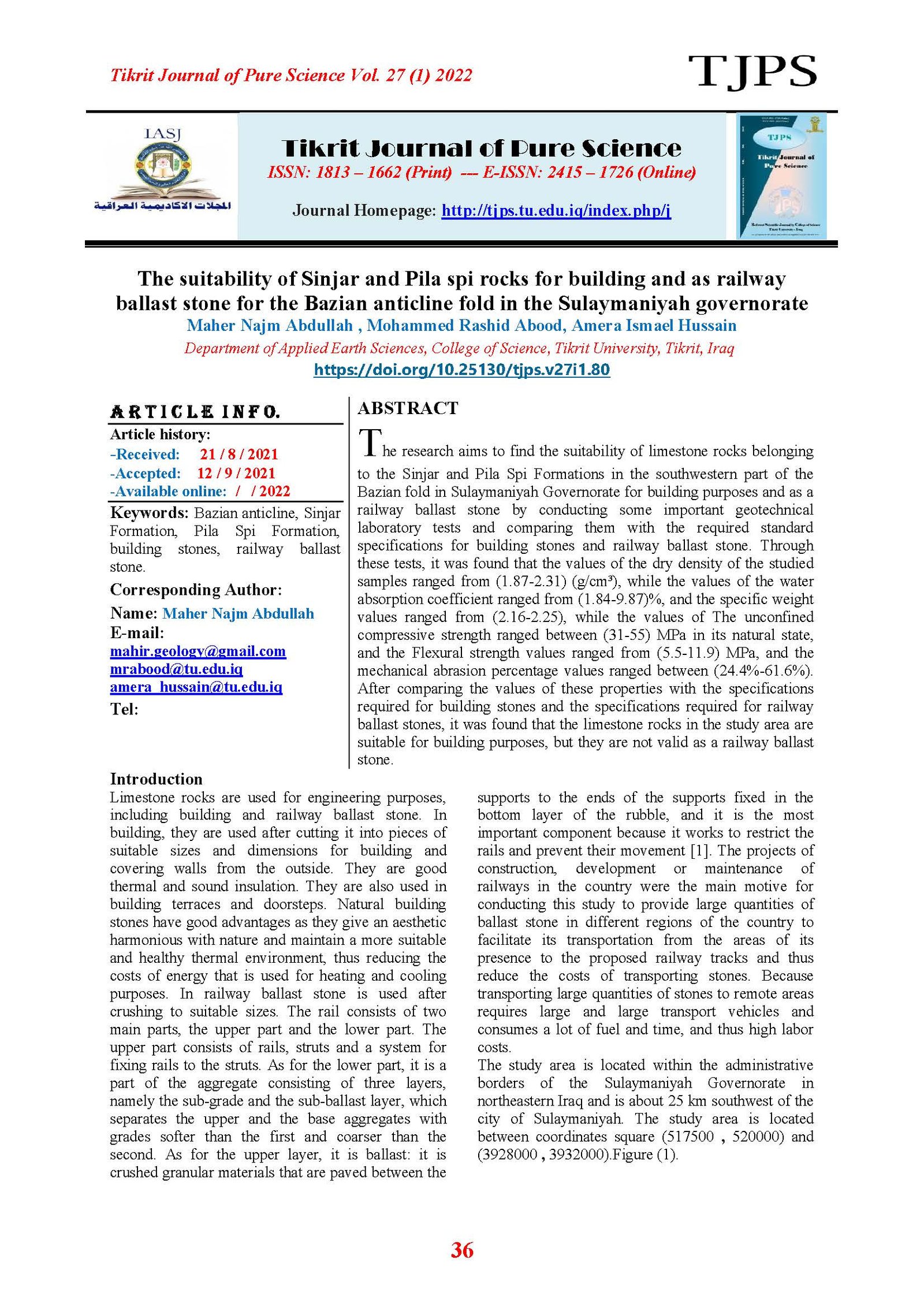The suitability of Sinjar and Pila spi rocks for building and as railway ballast stone for the Bazian anticline fold in the Sulaymaniyah governorate
Main Article Content
Abstract
The research aims to find the suitability of limestone rocks belonging to the Sinjar and Pila Spi Formations in the southwestern part of the Bazian fold in Sulaymaniyah Governorate for building purposes and as a railway ballast stone by conducting some important geotechnical laboratory tests and comparing them with the required standard specifications for building stones and railway ballast stone. Through these tests, it was found that the values of the dry density of the studied samples ranged from (1.87-2.31) (g/cm³), while the values of the water absorption coefficient ranged from (1.84-9.87)%, and the specific weight values ranged from (2.16-2.25), while the values of The unconfined compressive strength ranged between (31-55) MPa in its natural state, and the Flexural strength values ranged from (5.5-11.9) MPa, and the mechanical abrasion percentage values ranged between (24.4%-61.6%). After comparing the values of these properties with the specifications required for building stones and the specifications required for railway ballast stones, it was found that the limestone rocks in the study area are suitable for building purposes, but they are not valid as a railway ballast stone.
Article Details

This work is licensed under a Creative Commons Attribution 4.0 International License.
Tikrit Journal of Pure Science is licensed under the Creative Commons Attribution 4.0 International License, which allows users to copy, create extracts, abstracts, and new works from the article, alter and revise the article, and make commercial use of the article (including reuse and/or resale of the article by commercial entities), provided the user gives appropriate credit (with a link to the formal publication through the relevant DOI), provides a link to the license, indicates if changes were made, and the licensor is not represented as endorsing the use made of the work. The authors hold the copyright for their published work on the Tikrit J. Pure Sci. website, while Tikrit J. Pure Sci. is responsible for appreciate citation of their work, which is released under CC-BY-4.0, enabling the unrestricted use, distribution, and reproduction of an article in any medium, provided that the original work is properly cited.
References
[1] Lim,W. L., (2004) “ Mechanics Of Railway Ballast behavior” thesis of Doctor of Philosophy, University of Nottingham,England, p 216.
[2] HAMASUR, G. A. (2009) Rock Mass Engineering of the proposed Basara dam site Sulaimanni Kurdistan region, NE-Iraq, Doctorate thesis, University of Sulaymaniyah, College of Science, 182p.
[3] ASTM- C, 97-09., (2010) “Standard test methods for absorption and Bulk specific gravity of Dimension stone”3p.
[4] Griffin,J. A., (2008) “ development of a rating classification for rock to be used as toe- bench material” Master thesis,kent state university,131p.
- [5] ISRM., (1979) “Suggested Method for Determining the Uniaxial Compressive Strength and Deformability of Rock Materials” ISRM. Committee on Standarization of Laboratory Tests”. Int. J. Rock Mech. Min. Sci. & Geodesy. Abstr. Vol. 16. PP.137-140
[6] ASTM-C170-90., (2004): Standard Test Method for Compressive Strength of Dimension Stone, 3p.
[7] Grisafe, D.A.,(1976) ʻʻKansas Building Limestoneˮ , mineral Resources series, K.G.S University of Kasas.
[8] ASTM-C, 99-87., (2004) “Standard Test Method for Modulus of Rupture of Dimension Stone”3p.
[9] ASTM-C 99-09., (2010): Standard Test Method for Modulus of Rupture of Dimension Stone, 3p.
[10] ASTM-C 131-96., (2004): Standard test methods for Resistance to degradation of small- size coarse aggregate by abrasion and impact in the Los Angeles machine, 4p.
[11] ASTM-C, 568-99., (2004): Standard Specifications for Limestone Dimension Stone.2p.
[12] Organization of Road and Bridge design department, (O.R.B.D) 1999: Handbook for railway bridges, Iraq State Government,118p.
